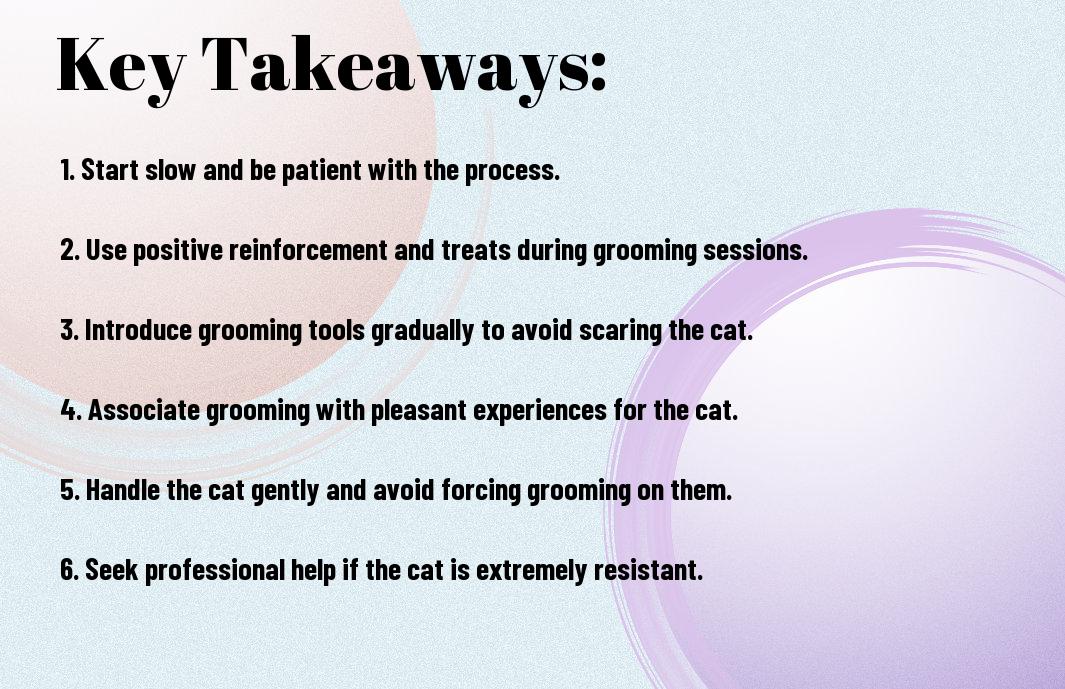Exacerbating the challenge of maintaining your cat’s grooming comes when they become anxious or resistant to the process. Attempting to groom an unwilling or anxious cat can lead to scratches, bites, and stress for both you and your feline friend. However, with patience and the right approach, you can train your cat to be more comfortable with grooming and make the process a more enjoyable experience for both of you. In this blog post, we will explore some effective tips and techniques to help you train your cat to be more at ease with grooming.
Key Takeaways:
- Start slow and be patient: Gradually introduce your cat to grooming tools and techniques, offering plenty of positive reinforcement along the way.
- Use treats and rewards: Associate grooming with positive experiences by offering treats and rewards during and after grooming sessions.
- Make grooming a regular part of your cat’s routine: By incorporating grooming into your cat’s regular schedule, they will become more accustomed to the process over time.
- Handle with care: Be gentle and cautious when grooming your cat to avoid causing any discomfort or stress.
- Seek professional help if needed: If your cat is especially resistant to grooming or has specific grooming needs, consider seeking help from a professional groomer or veterinarian.


Creating a Positive Grooming Environment
Clearly, creating a positive grooming environment for your cat is essential in helping them become more comfortable with grooming. By setting the stage for a positive experience, you can help reduce your cat’s anxiety and make the grooming process more enjoyable for both of you.
Choosing the Right Tools for Cat Grooming
When it comes to grooming your cat, it’s important to choose the right tools that will help make the process as comfortable as possible. Invest in high-quality grooming tools such as a soft-bristled brush and a fine-toothed comb specifically designed for cats. These tools will help you effectively remove loose fur and prevent matting, all while keeping your cat’s coat looking healthy and shiny. Avoid using sharp or noisy grooming tools, as they may cause unnecessary stress for your cat.
Setting a Calm and Welcoming Atmosphere
To create a calm and welcoming atmosphere for grooming, it’s important to choose a quiet and peaceful location for the grooming session. Find a place in your home where your cat feels safe and comfortable, such as a quiet room with minimal distractions. Additionally, consider playing soft music or using a calming pheromone diffuser to help create a soothing atmosphere for your cat. By setting the stage for a positive grooming experience, you can help your cat feel relaxed and at ease during the grooming process.
It’s not uncommon for cats to resist grooming, making it a challenging experience for both you and your feline friend. However, with patience and the right approach, you can help your cat become more at ease with grooming. Whether it’s brushing, nail trimming, or bathing, there are effective methods you can implement to make the process smoother for both of you. If you’re wondering how to train your cat for grooming, you can find helpful tips and strategies from other cat owners who have successfully trained their own cats.
Handling and Behavior Techniques
Despite how your cat may act when it comes to grooming, there are several handling and behavior techniques that can help make the process more comfortable for both you and your feline friend. By using these techniques, you can help your cat become more accustomed to grooming and reduce their stress levels.
Safely Restraining Your Cat for Grooming
When it comes to grooming, it’s important to know how to safely restrain your cat to prevent any unexpected movements that could harm you or your pet. Use a secure and comfortable cat restraint device to safely hold your cat in place during grooming. This not only prevents your cat from escaping but also reduces the risk of injury to both of you. Always make sure to use gentle but **firm** restraint, ensuring that your cat feels secure and unable to escape but not overly constrained.
Addressing Aggressive or Fearful Reactions
If your cat exhibits aggressive or fearful reactions during grooming, it’s essential to address these behaviors in a calm and **controlled** manner. Start by ensuring that the grooming environment is calm and quiet, eliminating any potential stress triggers. Additionally, desensitize your cat to grooming by gradually introducing them to the tools and the grooming process, rewarding **positive** behavior with treats and praise. If your cat continues to exhibit fearful or **aggressive** behaviors, consult with a professional **veterinarian** or animal behaviorist for guidance on how to best address these reactions.

Grooming Best Practices
Now that you have decided to train your cat to be more comfortable with grooming, it is important to understand the best practices for grooming. The right approach can make the experience more enjoyable for both you and your feline friend.
Establishing a Routine and Frequency for Grooming
To ensure that your cat becomes more comfortable with grooming, it is essential to establish a regular routine. Consistency is key when it comes to grooming. Set a specific time each day for grooming, and be sure to stick to it. This will help your cat become accustomed to the process and make it less stressful for both of you.
Tips for Specific Grooming Tasks (Coat, Nails, Ears, Teeth)
When it comes to grooming your cat’s coat, start by using a brush that is gentle and suitable for your cat’s fur type. Begin with short grooming sessions, gradually increasing the duration as your cat becomes more comfortable. When trimming your cat’s nails, be cautious not to cut them too short, as this can cause pain and bleeding. For cleaning your cat’s ears, use a soft cloth or cotton ball dampened with a specialized ear-cleaning solution to gently wipe the inside of the ears. Finally, for brushing your cat’s teeth, it’s best to start with a finger brush and gradually introduce a toothbrush designed for cats. This will help prevent dental issues and maintain your cat’s overall health. This will help prevent dental issues and maintain your cat’s overall health.
FAQ
Q: Why is grooming important for cats?
A: Grooming is essential for cats to maintain their coat, skin, and overall health. Regular grooming helps prevent matting, reduces shedding, and decreases the risk of skin infections. It also allows you to check for any lumps, bumps, or parasites on your cat’s body.
Q: How can I train my cat to be more comfortable with grooming?
A: Start by introducing your cat to grooming at a young age to help them become accustomed to the process. Use positive reinforcement, such as treats or praise, to create a positive association with grooming. Gradually introduce grooming tools, such as brushes or combs, and go at your cat’s pace. If your cat becomes stressed, take a break and try again later. Consistency and patience are key to helping your cat become more comfortable with grooming.
Q: What are some grooming techniques for cats?
A: Brushing your cat regularly helps prevent mats and reduces shedding. Use a soft-bristled brush for short-haired cats and a wider-toothed comb for long-haired cats. Trim your cat’s nails as needed to prevent them from becoming too long and causing discomfort or injury. It’s also important to check your cat’s ears and teeth regularly for any signs of infection or dental issues. If you’re unsure about any grooming techniques, consult a professional groomer or veterinarian for guidance.

Jayley, a devoted cat enthusiast, also writer for other cat blog as well. She aims to dedicated to providing comprehensive information, insights, and advice on everything you’d ever want to know about our whiskered companions.
